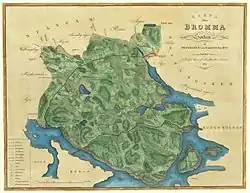Bromma socken, Sollentuna Hundred
Bromma socken is a former socken of Sollentuna Hundred in Uppland, Sweden. It became part of Stockholm City in 1916, and has been part of the municipalities of Stockholm and Sundbyberg since 1971.

The parish was about 25.05 square kilometres (9.67 sq mi) in area.[1] In 1903, the population was 2,220, before Sundbybergs köping (pop. 3,031) was included.[1] Ulvsunda Castle, Åkeshov Castle, the Johannelund estate, and Bromma Church were located in the former parish.
Etymology
The name of the parish (in 1344 Brumum) derives from the name of the kyrkby, the village or hamlet adjacent to the church. The word is of unclear meaning, perhaps from brumma, 'place for curing/drying leaves (e.g. for fodder)'. An alternative etymology proposes that the name is onomatopoetic, describing the murmuring "brumma" sound of a lake or harbour.[2]
Geography
Bromma Parish was located west of Stockholm, with Lake Mälaren to the south, Ulvsundasjön to the east, and Bällstaviken with Bällstaån Stream to the northeast. The smaller lakes of Lillsjön, Judarn, and Kyrksjön were located in the parish. The terrain in the north of the parish was predominantly flat plains, with hilly woodland in the south.[3]
Administrative history
Bromma Parish is first found in written records in 1314 (as De Brumum). Older still, Bromma Church dates back to the 12th century.[4]
With the municipality reform of 1862, the ecclesiastical administration of the parish was turned over to the local parish of the Church of Sweden (Swedish: Bromma församling), while secular responsibility fell under the jurisdiction of Bromma landskommun. In 1888, Sundbybergs köping was separated from the landskommun. Bromma landskommun was incorporated into Stockholm in 1916. On 1 May 1909, the ecclesiastical parish of Sundbyberg was separated from Bromma, and the ecclesiastical parishes of Västerled and Essingen followed suit in 1955.[5][6]
Men from the parish were conscripted into the Life Regiment Dragoons Corps. Sailors were conscripted into the Södra Roslags 2:a båtsmanskompani.[7][8]
References
- "Bromma socken" in the Nordisk familjebok (2nd edition, 1905)
- Mats Wahlberg, ed. (2003). Svenskt ortnamnslexikon. Uppsala: Institutet för språk och folkminnen. ISBN 91-7229-020-X. LIBRIS 8998039.
- Sjögren, Otto (1929). Sverige geografisk beskrivning del 1 Stockholms stad, Stockholms, Uppsala och Södermanlands län (in Swedish). Stockholm: Wahlström & Widstrand. LIBRIS 9938.
- Det medeltida Sverige 1:7
- Harlén, Hans; Harlén Eivy (2003). Sverige från A till Ö: geografisk-historisk uppslagsbok (in Swedish). Stockholm: Kommentus. ISBN 91-7345-139-8. LIBRIS 9337075.
- "Ändringar i församlingsindelningen 2000-2013" (Excel). Statistics Sweden. Retrieved 15 August 2012.
- Adm historik för Bromma socken. Source: Nationella arkivdatabasen, National Archives of Sweden.
- Om Roslags båtsmanskompanier